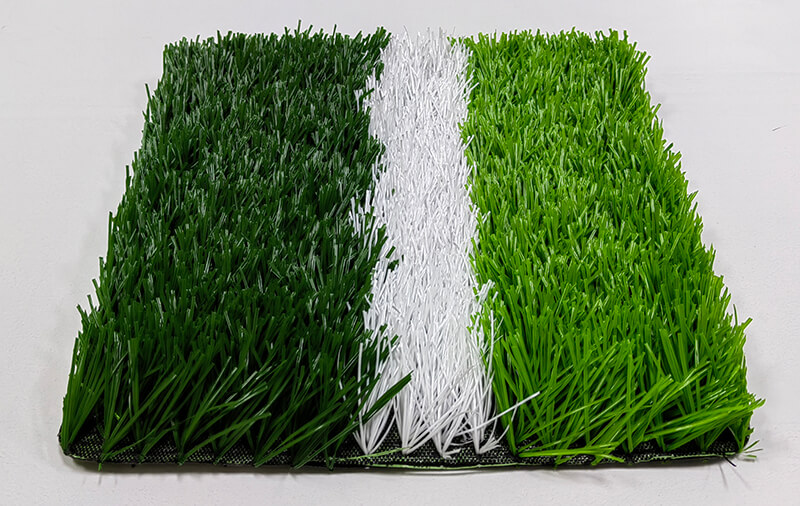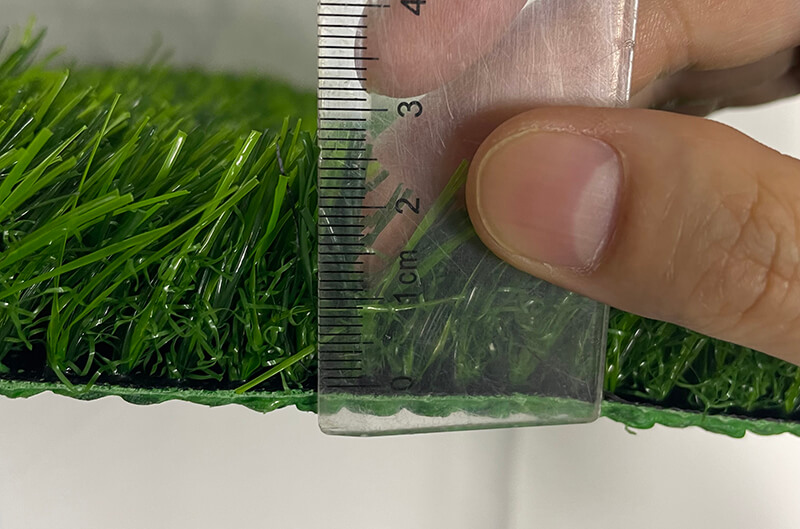
1. Introduction
Artificial lawns offer a beautiful, low-maintenance alternative to natural grass. They provide a lush, green appearance year-round with minimal effort. However, to get the most out of your artificial lawn, you need to install and maintain it properly.
In this article, we’ll highlight common mistakes homeowners make when setting up or caring for their artificial turf. You'll learn how to avoid these pitfalls and ensure your artificial lawn stays beautiful and functional for years to come.
![best 35mm Synthetic grass best 35mm Synthetic grass]()
2. Installation Mistakes
2.1 Inaccurate Measurements
Problem: One of the most common issues in artificial lawn installation is inaccurate measurement. Incorrect measurements can lead to buying too much or too little turf, resulting in delays and unexpected costs.
Solution: Always measure the area carefully before purchasing your turf. It’s recommended to measure twice and add a little extra to account for cutting and adjustments around edges and corners. Taking accurate measurements will save time and reduce the risk of over- or under-ordering. Mark the space with spray paint or string before purchasing the turf to visualize the area better. Plan for extra material to cover cutting and adjustments. Accurate measurements will help avoid any unwanted surprises.
2.2 Poor Site Preparation
Problem: Site preparation is crucial to the longevity and appearance of your artificial lawn. If the base is uneven or filled with debris, such as rocks or roots, it can lead to bumps, decay, and unpleasant odors.
Solution: Clear the site of any roots, rocks, or debris before beginning installation. After clearing, use a vibrating plate compactor to ensure a smooth, firm base. This ensures the artificial turf sits evenly and won’t develop problems over time. Pay attention to the drainage setup. If water doesn’t drain well, it can cause mold and odors under the turf. Ensure a slight slope for water to drain properly and prevent future issues. Properly compact the base for a smooth, long-lasting installation.
2.3 Lack of Drainage Planning
Problem: A lack of proper drainage planning can lead to standing water under your artificial lawn. This causes erosion, mold growth, and a shorter lifespan for the turf.
Solution: A good drainage system is essential to avoid pooling water. Use a permeable sub-base, such as crushed stone, to ensure water flows through the turf and away from the surface. Also, include a slight slope to help guide the water away from your home. In rainy climates, add drainage mats or channels underneath the turf to speed up water flow and avoid pooling.
2.4 Skipping Weed Barriers
Problem: Even though artificial grass is designed to be weed-resistant, weeds can still grow through seams or small drainage holes, leading to a messy, uneven appearance.
Solution: Installing a weed barrier underneath the turf is crucial. This geotextile membrane prevents weeds from growing through while allowing water to pass through. Secure the barrier in place with landscape staples to ensure it covers the entire area. Always overlap the seams of the weed barrier to avoid any gaps where weeds might sprout. Weed barriers are especially important if you live in an area with heavy weed growth. It’s a small investment for a much cleaner lawn.
2.5 Choosing the Wrong Turf Type
Problem: Not all artificial grass is the same. Some types are better suited for high-traffic areas, while others are ideal for landscaping or recreational spaces.
Solution: Select turf based on your intended use. For landscaping, choose soft turf with a realistic look. For high-traffic areas like sports fields or pet areas, go for more durable options with high tuft binding and a shorter pile height. Always opt for UV-resistant and non-toxic turf to ensure longevity and safety, especially for pets and children. Research the types of artificial grass available, and select the one that best meets your needs. Don’t settle for cheap alternatives that won’t stand the test of time.
2.6 Not Accounting for Blade Direction and Seaming
Problem: If the blades of artificial grass are not aligned correctly or if seams are poorly joined, your lawn can look uneven and unnatural.
Solution: Ensure that all sections of turf face the same direction, aligning the blades for a uniform appearance. Use high-quality seam tape and adhesive to join the sections and avoid visible seams. After installation, use a stiff brush to fluff up the blades and blend the seams to make the turf look more natural. Always check the blade direction before securing the turf. This will help avoid the patchy look that often occurs with poorly aligned sections.
Example of Proper Site Preparation vs. Improper Site Preparation
| Proper Site Preparation | Improper Site Preparation |
| Smooth, firm base with a slight slope for drainage | Uneven base with rocks and roots, causing bumps and poor drainage |
| Use of a vibrating plate compactor for a smooth surface | Lack of compaction, resulting in uneven turf surface |
| Installed weed barrier to prevent weed growth | No weed barrier, allowing weeds to grow through seams |
| Permeable sub-base like crushed stone to ensure water drainage | Solid base without drainage, leading to pooling water under the turf |
3. Usage Mistakes
3.1 Heat Damage
Problem: Placing hot items such as grills, fire pits, or hot pans directly on artificial grass can cause burns, discoloration, or irreversible damage to the fibers.
Solution: Always avoid placing hot objects on the artificial lawn. Consider using mats or heat-resistant pads under grills and fire pits to protect the turf from heat-related damage.
Tip: For safety, keep cigarette butts, barbecues, and hot cooking pans off the artificial lawn.
3.2 Heavy Objects
Problem: Heavy furniture, outdoor equipment, or objects with sharp legs can crush or tear artificial grass, leading to unsightly marks and damaged fibers.
Solution: Ensure heavy items, such as garden furniture or children’s play equipment, have wide, flat bases or use protective mats underneath to distribute the weight evenly. If possible, move these objects occasionally to prevent damage from prolonged pressure. Moving furniture or play equipment periodically helps distribute pressure evenly and prevents permanent marks.
3.3 Sharp Objects and Plastic Pools
Problem: Sharp objects, including pet toys or gardening tools, can cut through the turf, while leaving plastic pools or tarps on the lawn may cause wear or damage to the fibers.
Solution: Keep sharp objects off the lawn to prevent cuts or tears. Avoid leaving plastic pools or tarps on the turf for extended periods. These items can trap moisture beneath the surface, which may damage the turf over time. Regularly inspect your artificial lawn for any items left on it and remove them promptly to prevent damage.
4. Maintenance Mistakes
4.1 Using Harsh Chemicals
Problem: Harsh chemicals like bleach, ammonia, or other strong cleaning agents can cause discoloration, fading, and damage to the artificial grass fibers.
Solution: Clean artificial grass using gentle, natural cleaning solutions. Water with a mild soap or vinegar-based solution works well for most cleaning needs. Always test new cleaning agents on a small area of turf before using them widely. Avoid using bleach-based products as they can damage the turf fibers and shorten the lifespan of your artificial lawn.
4.2 Using Metal Rakes
Problem: Metal rakes can snag or cut the fibers of artificial grass, causing long-term damage and unevenness in the lawn’s appearance.
Solution: Instead of metal rakes, use a soft-bristled broom or a plastic rake to clean the surface. These tools won’t damage the fibers and can effectively remove debris.
4.3 Excessive Water Pressure
Problem: Using excessive water pressure can cause the fibers to flatten or loosen, leading to permanent damage.
Solution: Use moderate water pressure to rinse your artificial lawn. If you need to clean stubborn spots, opt for a gentle rinse rather than a powerful spray. A garden hose on low pressure is usually enough for regular cleaning.
Tip: Power washing may be effective, but be sure to use a low-pressure nozzle to avoid damaging the surface.
Conclusion
By avoiding common mistakes and following proper installation and maintenance practices, your artificial lawn will remain beautiful for years. With careful planning, installation, and regular upkeep, you can enjoy a lush, green lawn year-round. XiHY offers high-quality artificial turf that ensures durability, minimal maintenance, and a stunning outdoor space with long-lasting value.
FAQ
Q: What are the most common mistakes when installing an Artificial Lawn?
A: Common mistakes include inaccurate measurements, poor site preparation, lack of drainage planning, and skipping weed barriers. These errors can affect the lawn's appearance and longevity.
Q: How can I maintain my Artificial Lawn properly?
A: Regular cleaning with mild solutions, avoiding harsh chemicals, and using plastic rakes for debris removal are essential. Proper maintenance ensures the lawn remains lush and durable.
Q: Why is choosing the right type of Artificial Lawn important?
A: The right type of Artificial Lawn ensures durability and comfort, especially for high-traffic areas or pet spaces. It helps prevent wear and enhances the overall appearance.
Q: Can I use harsh chemicals to clean my Artificial Lawn?
A: No, harsh chemicals like bleach can damage the fibers. Use mild, natural cleaning solutions to preserve the lawn's color and integrity.













